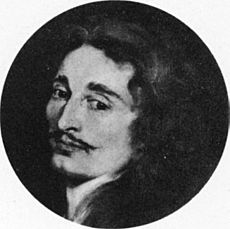Louis Le Vau facts for kids
Quick facts for kids
Louis Le Vau
|
|
|---|---|
| Born |
Louis Le Veau
c. 1612 |
| Died | 11 October 1670 (aged 57 or 58) |
| Nationality | French |
| Occupation | Architect |
| Buildings | Château de Versailles Château de Vincennes Vaux-le-Vicomte Louvre Palace |
| Design | Oval salon at Vaux-le-Vicomte |
Louis Le Vau (born around 1612 – died October 11, 1670) was a famous French Baroque architect. He worked for Louis XIV of France, who was the king at that time. Le Vau helped create the unique French Classical style of architecture in the 1600s.
Contents
Who Was Louis Le Vau?
Louis Le Vau was born Louis Le Veau in Paris, France, around 1612. His father, also named Louis Le Veau, was a stone mason. A stone mason is someone who works with stone to build things.
Louis had a younger brother, François Le Vau, who also became an architect. The father and his two sons often worked together in the 1630s and 1640s. Later, Louis and François changed their last name from "Le Veau" to "Le Vau." They did this to avoid confusion with the French word veau, which means "calf."
Early Buildings and Designs
Le Vau started his career in 1634 by designing a building called the Hotel de Bautru. By 1639, he was busy designing fancy town houses for rich people. These houses are called hôtels particuliers in French.
He built homes for important citizens like Sainctot, Hesselin, Gillier, Gruyn des Bordes, and Jean Baptiste Lambert. These houses were built on the île Saint-Louis, an island in Paris that was becoming a popular place to live. His most famous work from this time is the Hôtel Lambert, built between 1638 and 1653. Le Vau also designed country houses, like the Château de Livry.
Becoming the King's Architect
In 1654, Louis Le Vau's career took a big step forward. He was chosen to be the first architect to the king, taking over from Jacques Lemercier. This was a very important job!
His first big project for the king was helping to rebuild parts of the old Château de Vincennes. This was a medieval castle. Soon after, in 1656, he got an even bigger job. He was asked to build a grand castle for Nicolas Fouquet, a powerful government official. This castle was called Vaux-le-Vicomte.
For Vaux-le-Vicomte, Le Vau worked with other talented artists. André Le Nôtre designed the amazing gardens, and Charles Le Brun created beautiful decorations inside. Le Vau's most famous part of Vaux-le-Vicomte is the oval salon. This is a large, two-story room with a vaulted ceiling. It faces the garden and shows how a simple shape can be the main idea for a whole building.
Working on Royal Projects
In the 1660s, Le Vau helped with many royal projects for King Louis XIV. He worked on the hospital of La Salpêtrière. He also helped design the front of the Tuileries Palace.
From 1661 to 1664, Le Vau worked on rebuilding the Galerie d'Apollon inside the Louvre Palace. This part of the Louvre had been damaged by a fire. Later, other architects like Claude Perrault and Charles Le Brun helped create the famous east front of the Louvre. This design became a key example for Classical Architecture in the 1700s.
Designing the Palace of Versailles
The most important work of Le Vau's career was at the Palace of Versailles. He worked on Versailles for the rest of his life. He added new service wings to the front courtyards. After 1668, he completely rebuilt the garden side of the palace to have a more classical look.
Le Vau had an assistant named François d'Orbay. When Le Vau died, d'Orbay finished the work at Versailles. Later, another famous architect, Jules Hardouin-Mansart, made more changes and additions to Versailles.
Le Vau also designed the Collège des Quatre-Nations. This building now houses the Institut de France, a famous French institution. His assistant, François d'Orbay, completed this project after Le Vau's death. The design showed how Le Vau could use ideas from Italian Baroque architecture.
Louis Le Vau passed away in Paris in 1670.
Images for kids
-
Plan of the premier étage (first floor) of the Hôtel Lambert, with the Seine river nearby.
See also
 In Spanish: Louis Le Vau para niños
In Spanish: Louis Le Vau para niños










